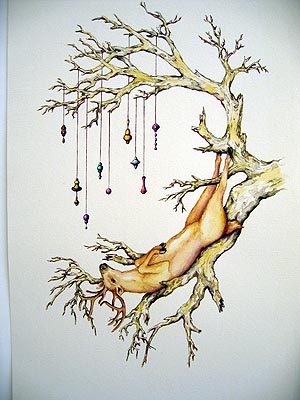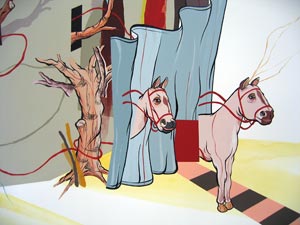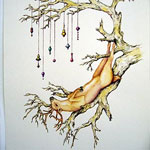Last week I went on safari in Grapeland, Texas. In true Texan style, I didn't get out of my car. I paid $5 and was turned loose to chase gazelles, zebras and llamas across a giant pasture in my middle-aged Volvo 840 wagon. Beast , at Finesilver Gallery, is like that: a sprawling, disorganized zoo of a show. They say shooting from a moving vehicle is dangerous, but there are so many targets, and so little time.
The show is mostly drawings, and most of the drawings are illustrations for imaginary children's books. Few artists have real knowledge of any animals but cats and dogs, which, being more popular and less avant-garde, are at the MFAH right now. So it's a show about the idea of animals in human culture, rather than about animals themselves.
It took me back to the "80s, another time when, fueled by a roaring, uncritical art market, artists turned to animals to add portentous meanings to merely stylish product. The styles have changed — a cool, technically proficient brand of illustration-based painting has replaced the grotesque scrabblings of neo-expressionism — but the superficiality has not.
Amy Jean Porter's endless series of birds are like pages ripped from a combination field guide and middle school speller: All the birds stand isolated on their pages, uttering single, cryptic words. "Pirate," says the prairie hen, spelling it correctly. "Pollution," sighs the whimbrel sadly, accidentally making a pointed statement. The juxtapositions of word and bird are occasionally curious, mostly not.
Her mammals are more sarcastic. The southeastern shrew, painted a Day-Glo yellow, is captioned with the phrase, "Your words have the extraordinary power to heal." Porter's drawings are pleasant, strongly evoking a tiny apartment, a desk by a window and crisp autumn afternoons spent painting these little critters. It's the Beatrix Potter urge, updated and marred by the dreary requirement that contemporary art be obscure and avant-garde. Hence, the yellow shrew.
Scott Calhoun's paintings evoke a dated world of repressed sexual fantasy and excess, part exotic orientalism, part bestiality and part fairy tale. Collaged cutouts of tiny furry animals and nude women populate precious, pseudo-Chinese landscapes. Artfully spattered and faded, they simulate the yellowed antiquity of Victorian engravings. If you play along and imagine them as part of an illustrated storybook, it's easier to accept the mannered atmosphere. Ambiguous stories gain interest: Little Chinese people lasso birds for a full-skirted 19th-century lady. A giant shrew caresses a reclining nude amid mossy rocks. Childhood + sexuality = icky, and ickiness is Calhoun's strongest point. It's easy, but icky is better than dull, and there are a lot more people who go for that sort of thing than will admit it.
Scott Burns and Mark Mulroney clip and rearrange bits of nostalgic illustration-style figuration to create fragmented surreal narratives. Mulroney draws his style from underground comix and Saturday morning cartoons; Burns, from mid-century magazine illustration. Both use technical proficiency to give weight and unity to incomprehensible collages. Mulroney's velvety paint and fluid linework are admirable. Likewise, Burns" vintage-tinted watercolors could grace the Saturday Evening Post . Mulroney's A static glow illuminates my future is a surrealist opera on the theme of transportation: A domelike gray boulder/hut/barn dominates the scene. From it emerge fragmentary horses and the back end of a motorboat. Nearby, a speeding motorcycle is tied to a gnarly dead tree. Waving arms and branches appear from dark slots. In Burns" watercolors, it's deer that are tied to the gnarly, dead trees. As in Mulroney's pictures, colored ribbons loop and connect things that don't connect.

Kathryn Spence...Untitled (Snowy Owl) 2006...Stuffed animals, plastic bag, curtains,...wire and thread...life sized
These artists leave questions unanswered, stories unfinished, and that's a problem. In classic surrealism, things are juxtaposed without the pretense of meaning. Slapping odd images together to see what happens was a lighthearted game with sometimes disturbing, unexpected results. For Burns and Mulroney, it's no game: Intentionally looking for loaded imagery, they bypass the unexpected and end up rehashing the imaginations of others.
Seth Alverson's Ruins and the shape of the Mastodon is better — less shy of direct storytelling. An eyeless, trumpeting mass of hair conquers a ruined Tinkertoy village.
Dan Fabian's drawings, next door at Kinzelman Art Consulting, show how it ought to be done: Curious, understated situations are presented in clean, matter-of-fact pen lines. They have less drama than Burns, Mulroney or Alverson, but more sticking power — I'm still thinking about them weeks later.
Trophies have a special, creepy power and are another sweet spot for artists looking for a quick significance. Elaine Bradford crochets new, wooly skins for trophy bucks. It's another easy idea, overlaying a traditionally masculine icon with a layer of cozy feminine craft. Her Untitled (Peas and Carrots) extends the buck's horns into a gallery-filling tree, making an installation of an object but little more. Sharon Engelstein's glamorized critters take it a step further; her Otter with Cape gains a regal, if diminutive, presence from its finery. Tiffany Calvert's solemn, churchy trophy room and Ken Little's deftly characterized trophy heads made from used shoes both treat trophies as bizarre pieces of decor rather than mementoes of healthy outdoor sport.
It's a good-looking show, a pleasant show and a well-crafted show, but not a challenging one. Adam Ogilvie's cardboard apes, Laurie Hogin's gun-toting marmosets, Ricardo Lanzarini's micro-doodle placemats, Lloyd Walsh's Caravaggiesque giraffe portrait, Adia Millet's embroidered roaches and Cassandra Jones" flamingo wallpaper are all slightly facile, as if made by overstimulated art students searching for convenient outlets for their new technical skills. Ken Little and Mark Flood are exceptions. Little has found his niche; if you want witty animal caricatures in used shoes, no one does it better. Little's trophy heads have an unpretentious, raucous fun that begins and ends in visual punning. Flood's cynical mutant lawn bunnies make Jeff Koons" stupid high art/low art jokes even stupider by replaying them. Cast in bronze, the wascally wabbits retail for $10,000 a pop. The punch line: someone might be cynical enough to buy one.
Oh, and don't miss Kathryn Spence's Untitled (Snowy Owl). Placed almost under a shelf, in a corner and white, it's easy to overlook, but it has a mute, ragged gravity, combining the dignity of wildlife and the pathos of an unraveling stuffed toy.
Images courtesy Bill Davenport and Finesilver.
Bill Davenport is an artist and writer living in Houston. He was one of the first contributors to Glasstire.





